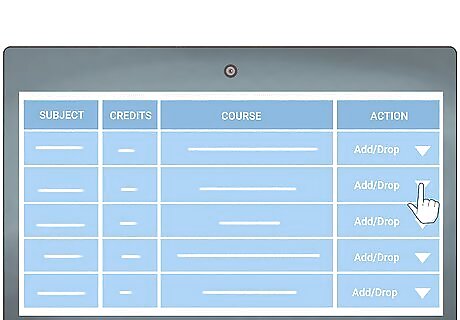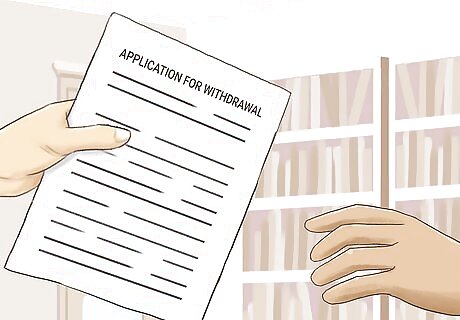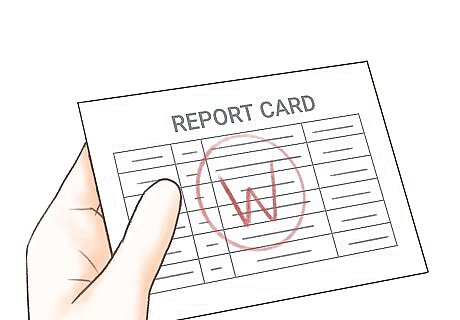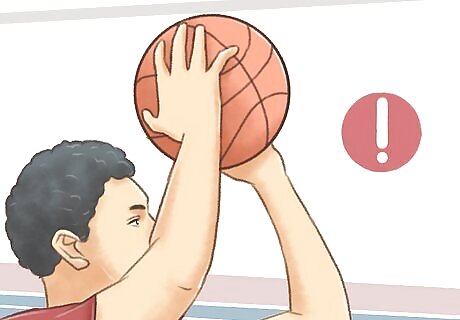
views
Withdrawing from the Class

Check your school's deadline for withdrawal. The deadline to withdraw is typically set three quarters of the way through the semester For a full semester, 12-week class, the withdrawal deadline will be around week eight. If the deadline has passed, you will have to stick with the class and receive a letter grade. Check your school's website or administrative offices for the official deadline. Early on in the semester, before the term or the class itself begins, you can drop a class instead of withdrawing. Dropped classes don't show up on your transcript and can be replaced with other classes. If the withdrawal deadline has passed, you may be able to attempt a late withdrawal. This must be done through the registrar's office. You will most likely not succeed with this unless you withdraw because of military service or medical issues.

Withdraw online through your student account. Log into your student account and go to the class registration area. Look for an “add/drop” tab. You'll see a list of your classes. Click on the “withdraw” option in the drop-down box. Each institution has its own withdrawal process. Yours may not allow withdrawal this way.

Contact the registrar's office to withdraw. If online withdrawal isn't an option, you will have to speak to someone. Go in person to the registrar's office to get a class withdrawal sheet. Some institutions also accept withdrawals through email. Look on your school's website for an email address for the registrar's office or the academic advisor's office. When in doubt, contact an academic advisor. They can help you submit the proper forms.

Fill out your student information. What you need to submit depends on your school. You will need your name, student ID number, and the name of your class. You may also need explain why you are withdrawing or get a signature from your teacher or advisor.

Return the form. Submit the withdrawal form to the registrar's office or send the email. The office should quickly notify you that the withdrawal process is complete. Check your student account and transcript to see that the withdrawal is official. Go to the class until you are certain you've withdrawn. Missing class doesn't count as a withdrawal and can lead to a failing grade on your transcript.
Reasoning through Withdrawal

Be realistic about your reason for withdrawing. Ask yourself why you need to withdraw. Withdrawing is better than getting a poor grade, so if you know you can't succeed in a class it's a good option. However, it may be better to continue on with the class now rather than take it over again. A withdrawal means a W grade on your report card. A W won't be a big deal to employers unless they see a pattern of withdrawals through multiple semesters. When stress is the problem, consider making other changes. Step back from extracurricular activities and leadership roles, for example, or set a better study schedule.

Speak to an advisor. An academic advisor can help you understand the withdrawal process. They may also be able to help you manage your situation so you don't have to withdraw. An advisor may steer you to different options, such as taking the class with a pass/fail grade, receiving an “incomplete” grade, or tutoring. Check in with your instructor or teaching assistant too. Either person may be able to work out a plan to help you succeed in the class. If you're in middle or high school, talk to your school counselor. They'll advise you whether the class is required or whether it will affect the number of courses you need to take each semester.

Make sure the withdrawal won't affect you financially. While withdrawing is a valid option, your financial aid or credit load may still be affected. When you fall below a certain amount of credits, you may lose financial aid or have to give back money. Consult school policy and the terms of your financial aid agreement. Some schools may charge a fee for withdrawing or repeating a class. In addition, you will have to pay to take the class again and may need new books. For some students, staying in the class may be cheaper. For example, you may gain more from reducing your work hours and getting an emergency loan from the school instead of retaking the class.

Ensure your eligibility is safe. Athletes and international students must adhere to a credit load minimum set by the school. Because the withdrawn class won't count for credits, you may lose athletic eligibility or your visa status. Be sure to check with coaches and international student advisors first. Also, withdrawal can cause you to fall behind as a student. If this is a required class, you'll have to take it again, which delays your progress towards completing your program.




















Comments
0 comment